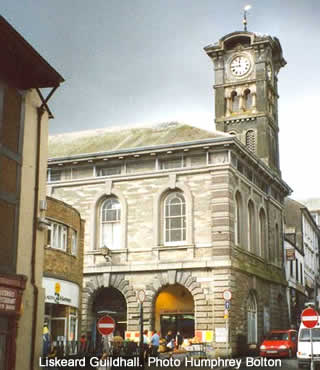Liskeard |
|
 |
|||
A market town with a strong mining heritage |
|||||
Listen to this article |
|||||
|
|||||
Throughout the Middle Ages, Liskeard was always a successful market and agricultural town. In the 19th century, it again achieved prosperity via the tin mining industry. This has since faded away, leaving the town to return to its roots. The market still happens twice a week. On Thursdays, there's one of the very few remaining weekly livestock markets in Cornwall. |
|||||
There are plenty of other shops too; this is a commercial centre for the eastern region of the county. Still, it has held on to much of its character. You can see the medieval street pattern, and lots of old buildings. The Victorian Guildhall, for example, is crowned by a huge clock tower that's the town's main landmark. Stuart House is so named because King Charles I, of the Stuart family, stayed there in 1644. Today, it's widely used for community events like concerts, lectures and craft shows. There's a permanent civil war exhibition, and plenty of other information on local history. Outside is a traditional, 17th-century "Gentlemen's Garden". |
|||||
St. Martin's, Liskeard's main church, is the third largest in Cornwall. A stained glass window depicts the story of the eponymous Martin, a Roman military officer who cut his own cloak in half to share it with a beggar. |
|||||
The church isn't the only building in town to tell a story. Others, scattered throughout Liskeard, are decorated with large murals. They show the important events that changed east Cornwall, like the Industrial Revolution and the coming of the railway. |
|||||
Local history is explained more thoroughly at Liskeard District Museum. It looks at each of the town's main eras, including agriculture, mining and the war. Then it pinpoints the specific people who had the biggest effect on life here in Cornwall. |
|||||
If you track down the nearby Ancient Pipe Well, you'll find the reason why the settlement of Liskeard was probably started in the first place. It's supplied by four springs, and has never been known to run dry. It times past it was thought to cure illness, including blindness! |
|||||
Another well, at St. Cleer on the edge of town, was also thought to have healing powers. Specifically, it could be used to treat insanity. This meant that people deemed "insane" were often brought here, and tossed up and down in the water until they came to their senses. |
|||||
In the old days, a canal link to Looe provided transport for the mining industry. This has since been replaced by a picturesque rail line, following the same course along the wooded waterside. Looe itself is a popular seaside town with plenty to do, but it's worth stopping off along the way, too. A particular highlight is the Real Ale Trail, a group of 11 country pubs close to the railway's stations. Before your drink, you can take a self-guided walk via the Trails From The Track scheme. Each one starts and ends at one of the stations, with some loops lasting just 2 miles, and others going on for over 10. |
|||||
On the other side of Liskeard, to the north-west, is Bodmin Moor, where ancient history mixes with the whispers of myth and legend. Bronze Age burial chambers and stone monuments provide evidence of this area's true past, as a human habitat for many millennia. On the other hand, there might also be a shadow moving somewhere on the horizon, hinting at the existence of the deadly beast that's said to roam these moors. |
|||||
|
|||||
Liskeard Tourist Information Centre, Foresters Hall, Pike Street, Liskeard, PL14 3JE. Tel: 01579 349148 |
|||||
|
Pocket Britain is optimised for use on a smartphone or tablet with internet access. All content is subject to copyright. All reasonable methods have been used to ensure information supplied is accurate at the time of publication. However, it is advisable to check information before relying on it. Privacy Policy |